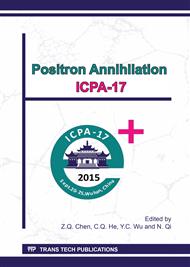[1]
G.R. Odette, G.E. Lucas, Recent progress in understanding reactor pressure vessel steel embrittlement, Radiat. Eff. Defect. S 144 (1998) 189-231.
DOI: 10.1080/10420159808229676
Google Scholar
[2]
W.J. Phythian, C.A. English, Microstructural evolution in reactor pressure vessel steels, J. Nucl. Mater. 205 (1993) 162-177.
DOI: 10.1016/0022-3115(93)90079-e
Google Scholar
[3]
M.K. Miller, K.F. Russell, Embrittlement of RPV steels: An atom probe tomography perspective, J. Nucl. Mater. 371 (2007) 145-160.
DOI: 10.1016/j.jnucmat.2007.05.003
Google Scholar
[4]
Y Nagai, Z Tang, M Hassegawa, T Kanai, M Saneyasu, Irradiation-induced Cu aggregations in Fe: An origin of embrittlement of reactor pressure vessel steels, Phys. Rev. B 63 (2001) 134110.
DOI: 10.1103/physrevb.63.134110
Google Scholar
[5]
E. Meslin, M. Lambrecht, M. Hernandez-Mayoral, F. Bergner, L. Malerba, P. Pareige, B. Radiguet, A. Barbu, D. Gomez-Briceno, A. Ulbricht, A. Almazoui, Characterization of neutron-irradiated ferritic model alloys and a RPV steel from combined APT, SANS, TEM and PAS analyses, J. Nucl. Mater. 406 (2010).
DOI: 10.1016/j.jnucmat.2009.12.021
Google Scholar
[6]
P.J. Othen, M.L. Jenkins, G.D.W. Smith, W.J. Phythian, Transmission electron microscope investigations of the structure of copper precipitates in thermally-aged Fe-Cu and Fe-Cu-Ni, Phil. Mag. Lett. 64 (1991) 383-391.
DOI: 10.1080/09500839108215121
Google Scholar
[7]
P.D. Styman, J.M. Hyde, K. Wilford, A. Morley, G.D.W. Smith, Precipitation in long term thermally aged high copper, high nickel model RPV steel welds, Prog. Nucl. Energ. 57 (2012) 86-92.
DOI: 10.1016/j.pnucene.2011.10.010
Google Scholar
[8]
Y. Nagai, K. Takadate, Z. Tang, H. Ohkubo, H. Sunaga, H. Takizawa, M. Hasegawa, Positron annihilation study of vacancy-solute complex evolution in Fe-based alloys, Phys. Rev. B 67 (2003) 224202.
DOI: 10.1103/physrevb.67.224202
Google Scholar
[9]
M.J. Konstantinovic, G. Bonny, Thermal stability and the structure of vacancy-solute clusters in iron alloys, Acta Mater. 85 (2015) 107-111.
DOI: 10.1016/j.actamat.2014.11.026
Google Scholar
[10]
L. Tan, J.T. Busby, Formulating the strength factor for improved predictability of radiation hardening, J. Nucl. Mater. 465 (2015) 724-730.
DOI: 10.1016/j.jnucmat.2015.07.009
Google Scholar
[11]
G. Xu (Ph.D. thesis), The effect of thermal aging on the microstructure and impact property of RPV model steel, Shanghai University, 2012, p.89.
Google Scholar


